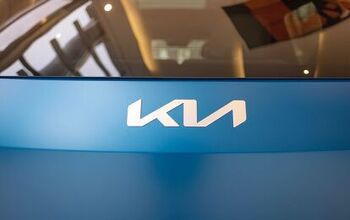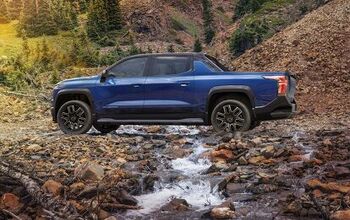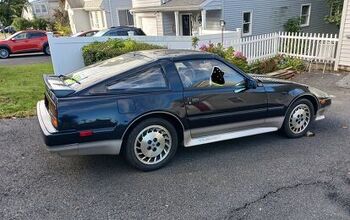GM Revamps OnStar: Take a Long Look In the Mirror

When General Motors first deployed OnStar, it was a little more than an emergency services hotline. Drivers in need could tap a blue button on their rearview mirror and immediately get in contact with an operator. The system could also do this automatically in the event of a crash. OnStar later introduced anti-theft measures, turn-by-turn navigation, and remote access as part of a subscription plan.
However, with General Motors seeing dollar signs wherever connectivity is involved, the automaker wants to retool the system. OnStar will continue offering existing services, but GM is changing the subscription model and placing a new emphasis on data acquisition. The good news is that the tiered payment model will offer more features starting in May. Unfortunately, some those amenities used to be free and those fed up with companies selling your data or paranoid about Orwellian Big Brother scenarios might be less enthusiastic about the long-term corporate vision.
In reality, the latter half of that equation isn’t really any more sinister than what’s currently being offered. OnStar can already keep track of and access your vehicle remotely. The difference is that GM is going to attempt to collect that data more effectively and monetize it for financial gain. The upshot is that it comes with new tech and connectivity features some of the public is likely to be very interested in — like in-car shopping and delivery services or advanced vehicle diagnostics sent directly to the dealership.
We’ve already seen the company pushing e-commerce via its Marketplace app. One of the more recent pilot programs involves a digital gas-payment system via its partnership with Shell. But GM has been offering digital purchasing deals through Groupon, Priceline, ExxonMobil through OnStar’s At Your Service for years now. Now it’s ramping those up by syncing more preferred (i.e. partnered) brands with its onboard Marketplace app.
One of the weirder ones is with Amazon, which allows OnStar to remotely provide access to delivery drivers if you want them to drop packages off inside your car. Provided you’re comfortable with someone accessing your vehicle to make a drop, it’s actually a handy little feature.
General Motors sees non-core businesses as a $1.5 billion profit growth opportunity, and a significant portion of it takes place behind the scenes. Monetizing data is something many automakers are looking into and GM is right at the front of the pack. But that only works if a lot of people sign up for OnStar, so the company is sharing revenue with dealers who encourage customers to sign up.
Gerard Connell, director of sales and marketing for global connected customer experience, told Automotive News OnStar’s longterm strategy will continue to expand its services as GM focuses on data. Last week, during the Amazon announcement, CEO Mary Barra noted that the automaker will also expand into areas “that will generate revenue and profitability as we leverage the connectivity and then the ability to monetize data both in the vehicle and sharing it with other companies.”
In the short term, that means restructuring for OnStar. Starting this week, the service will go from three plans to five. The most basic is the $14.99 per month Remote Access package. That service, while previously free, allows customers to control key fob functions through their smartphone. Now, drivers will have to pay for the privilege. Connell says it’s worth it because it includes diagnostic services and other amenities.
“Really, the primary purpose of that basic plan is to make sure we know what’s going on with the car,” he said. “We can get them to a dealership and we can help them understand the state of their car.”
Stepping up to $24.99 a month grants customers access to OnStar’s Security package. This includes roadside assistance, navigation, and stolen-car recovery services. More expensive plans include additional connectivity services with the all-inclusive Connectivity, Safety, and Security package, coming in at $59.99 per month. As the most expensive tier, it comes bundled with unlimited data as well.
Overall, the new pricing makes everything a bit more expensive on the low and high end of the spectrum, but includes additional data services. You could argue that the prices should come down if General Motors plans to market to you directly through your car while selling your data to other companies.
It’s a shrewd move on the part of GM, and it’ll likely impress investors and boost revenue, but we’re less than enthusiastic about the strategy from the perspective of consumers. They’re losing some features that used to be free and opting into becoming both customer and commodity as a result of GM’s new data acquisition angle. Perhaps that’s the price of progress, but we’re wondering if it should be. We hope the automaker exercises some restraint and prioritizes the welfare of its consumer base as it continues hunting for alternative revenue streams and interesting new services.
In the meantime, you’ll have to take a look in the mirror and decide what you’re willing to put up with.
[Image: General Motors]

A staunch consumer advocate tracking industry trends and regulation. Before joining TTAC, Matt spent a decade working for marketing and research firms based in NYC. Clients included several of the world’s largest automakers, global tire brands, and aftermarket part suppliers. Dissatisfied with the corporate world and resentful of having to wear suits everyday, he pivoted to writing about cars. Since then, that man has become an ardent supporter of the right-to-repair movement, been interviewed on the auto industry by national radio broadcasts, driven more rental cars than anyone ever should, participated in amateur rallying events, and received the requisite minimum training as sanctioned by the SCCA. Handy with a wrench, Matt grew up surrounded by Detroit auto workers and managed to get a pizza delivery job before he was legally eligible. He later found himself driving box trucks through Manhattan, guaranteeing future sympathy for actual truckers. He continues to conduct research pertaining to the automotive sector as an independent contractor and has since moved back to his native Michigan, closer to where the cars are born. A contrarian, Matt claims to prefer understeer — stating that front and all-wheel drive vehicles cater best to his driving style.
More by Matt Posky
Latest Car Reviews
Read moreLatest Product Reviews
Read moreRecent Comments
- Buickman I was called crazy after predicting the sale of GMAC.#canthurtme
- 3-On-The-Tree Another observation during my time as a firefighter EMT was that seatbelts and helmets do save lives and reduce injury. And its always the other person getting hurt.
- 3-On-The-Tree Jeff, Matt Posky, When my bike came out in 1999 it was the fastest production motorcycle in the world, 150 HP 197 top speed, 9.57 quarter mile Hayabusa peregrine falcon etc. This led to controversy and calls for high-speed motorcycles to be banned in order to avoid increasingly fast bikes from driving on public roads. This led to a mutual decision nicknamed the “ gentleman’s agreement” to limit bikes to 186mph, ending the production bike speed contest for all bikes 2000 and upward. Honestly once your over a buck 20 it’s all a blur. Most super cars can do over or close to 200mpg, I know at least on paper my 09 C6 corvette LS3 tops out at 190mph.
- 3-On-The-Tree In my life before the military I was a firefighter EMT and for the majority of the car accidents that we responded to ALCOHOL and drugs was the main factor. All the suggested limitations from everyone above don’t matter if there is a drunken/high fool behind the wheel. Again personal responsibility.
- Wjtinfwb NONE. Vehicle tech is not the issue. What is the issue is we give a drivers license to any moron who can fog a mirror. Then don't even enforce that requirement or the requirement to have auto insurance is you have a car. The only tech I could get behind is to override the lighting controls so that headlights and taillights automatically come on at dusk and in sync with wipers. I see way too many cars after dark without headlights, likely due to the automatic control being overridden and turned to "Off". The current trend of digital or electro-luminescent dashboards exacerbates this as the dash is illuminated, fooling a driver into thinking the headlights are on.

































Comments
Join the conversation
I find the $20 per month all-you-can eat data to be quite a deal. Sign up for it most months we do a road trip. The kids and spouse can surf to their hearts content and is a better signal than sharing a cellphone Wi-Fi hotspot.
Onstar in the cars, whether I want it or not, is a primary reason GM product hasn't been on my cars-to-check-out-list for about 18 years now. I remember a conversation with a car dealer circa 2002. I was looking at a very well equipped Impala and asked for a non-Onstar option. They told me it wasn't possible, standard equipment. I then asked for Onstar to be disconnected before delivery. Nope, not possible. You disconnect Onstar and the car won't run. I ended up with a Hyundai Tiburon instead (yes, I know....but I didn't know any better).